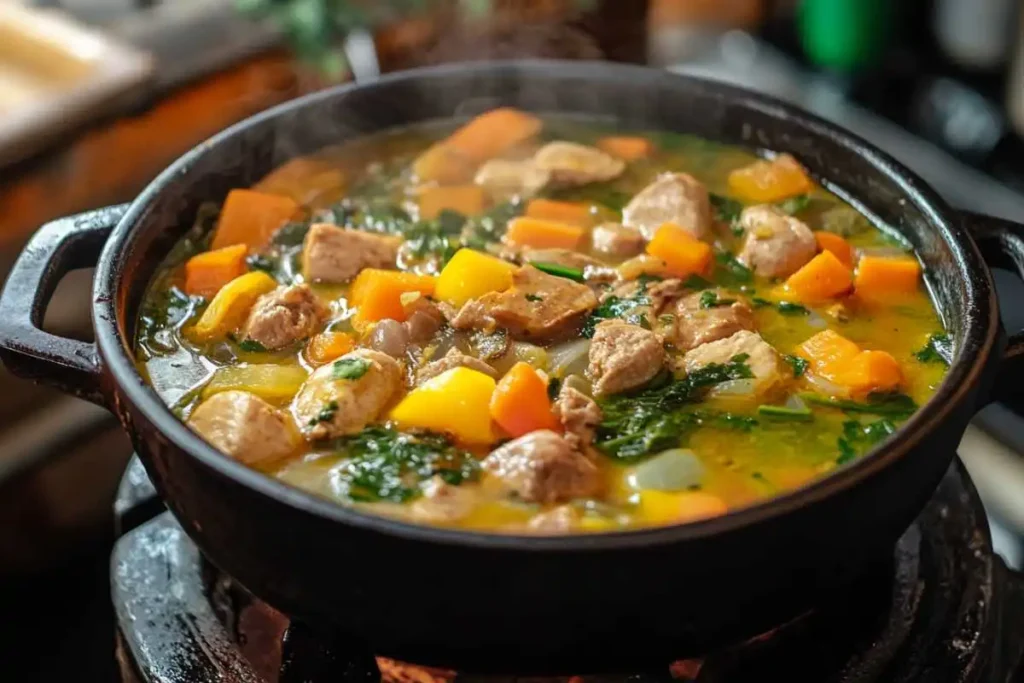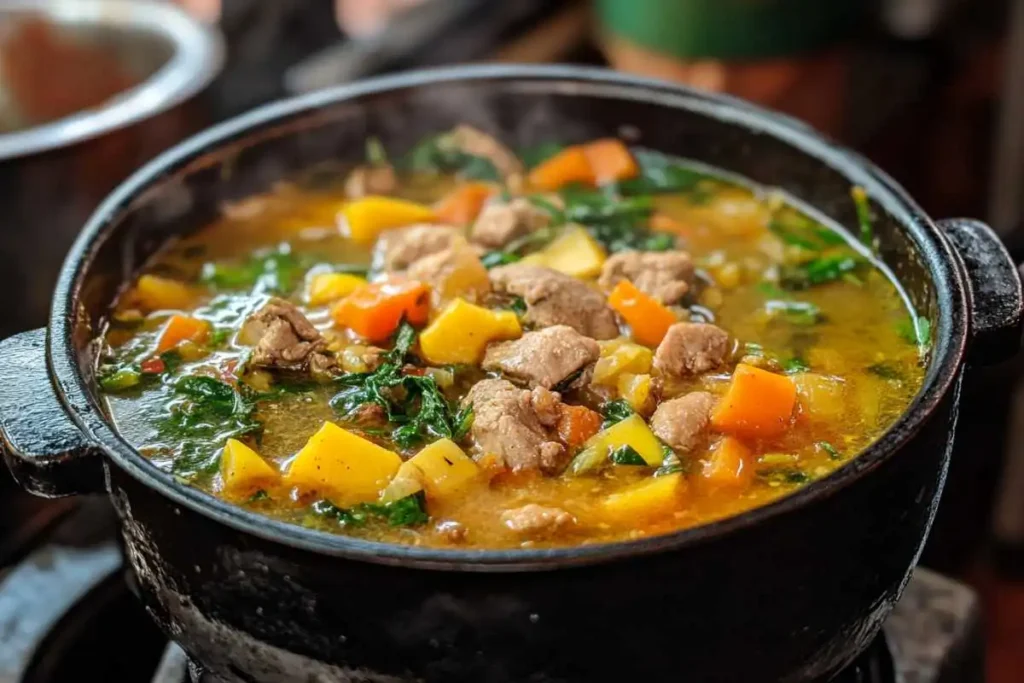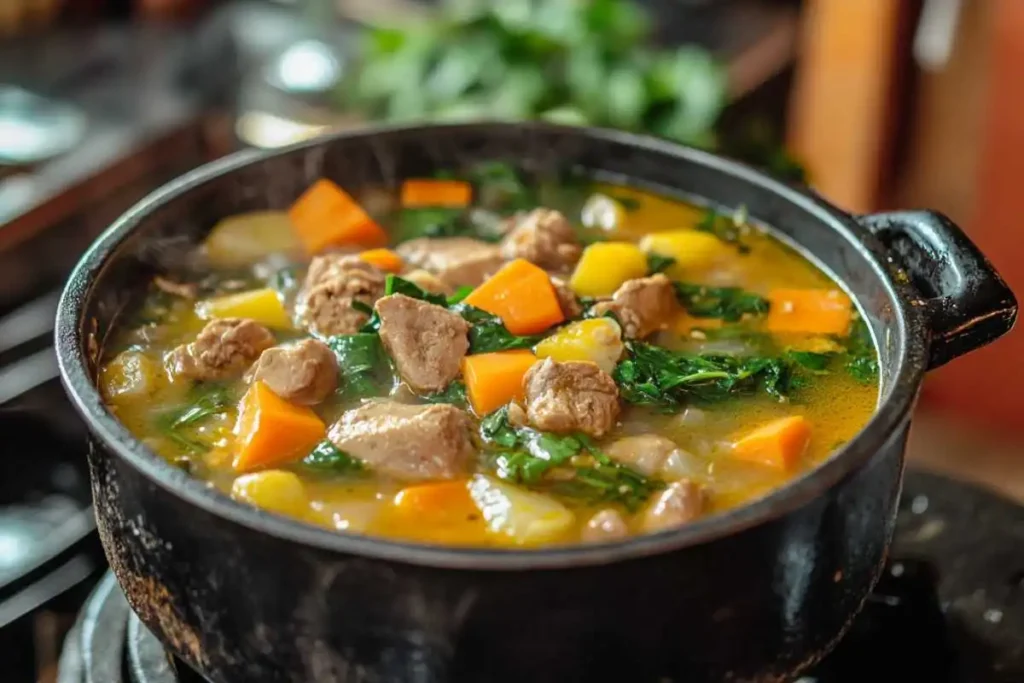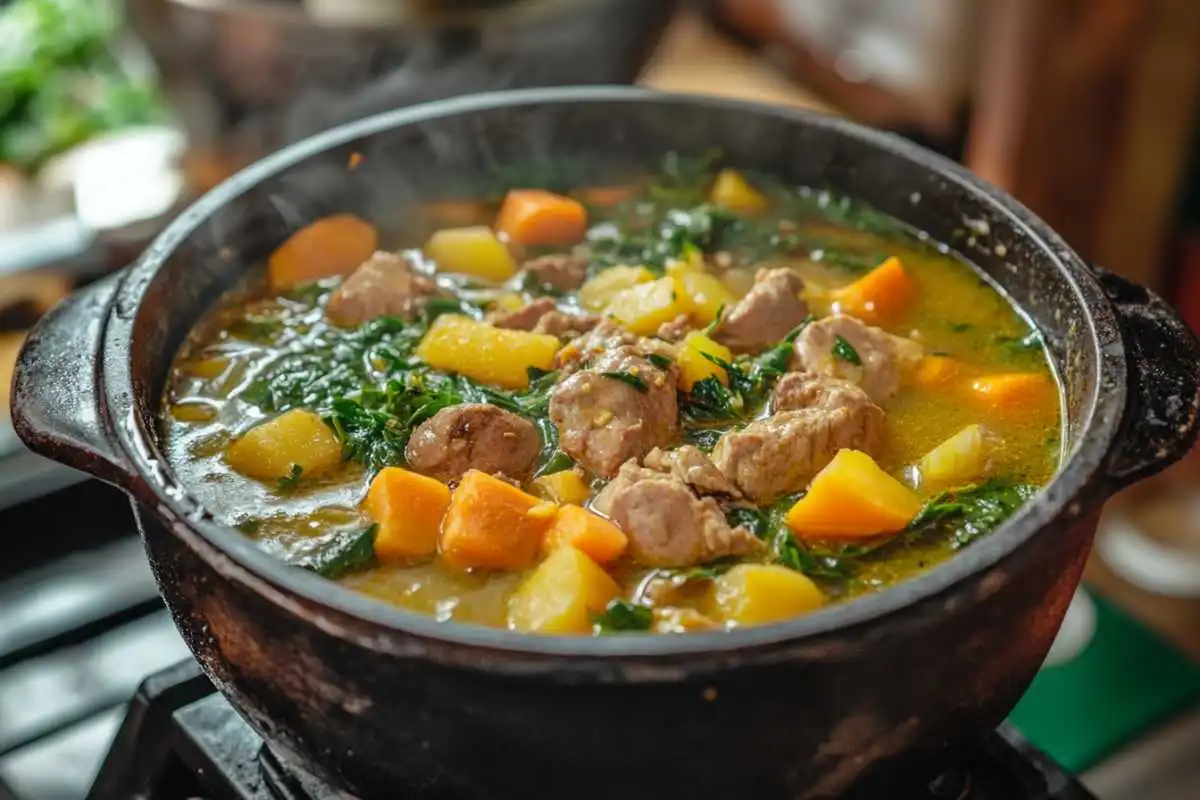Jamaican soup is a beloved staple in the island’s cuisine, known for its bold flavors, rich ingredients, and cultural significance. This culinary treasure is more than just a meal—it represents the heart of Jamaican traditions and community gatherings.
Introduction
The Cultural Significance of Jamaican Soup
A Communal Tradition
In Jamaica, soups are often the centerpiece of family meals and special occasions. They bring people together, serving as a symbol of warmth and hospitality. Whether enjoyed on a relaxed Saturday or during festive celebrations, Jamaican soup fosters a sense of togetherness.
A Reflection of Jamaican Heritage
Jamaican soup embodies the island’s diverse cultural influences, blending African, European, and indigenous culinary traditions. This fusion is evident in the variety of ingredients and cooking techniques used to create these flavorful dishes.
For more on how food reflects cultural symbolism, explore cakes that symbolize celebrations to see parallels in other cuisines.
Key Ingredients of Jamaican Soup
The bold flavors of Jamaican soup come from a mix of fresh, local ingredients and carefully selected spices.
Proteins
- Chicken: Common in Jamaican Chicken Soup, providing flavor and richness.
- Beef or Goat: Often used in hearty broths like Red Peas Soup.
- Fish: The star ingredient in Fish Tea, delivering a light and refreshing base.
Starches
- Yam and Sweet Potatoes: Add heartiness and balance the spices.
- Dumplings: Known as “spinners,” these are flour-based and enhance the soup’s texture.
- Green Bananas: A staple in many Jamaican soups, contributing a mild sweetness.
Vegetables
- Pumpkin: Used in Jamaican Chicken Soup for a creamy texture.
- Cho Cho (Chayote): Adds a unique flavor and crunch.
- Carrots: Bring natural sweetness and a vibrant color.
For ideas on incorporating additional flavors into your cooking, check out flavors that complement apricots for inspiration.
Popular Types of Jamaican Soup
Jamaican Chicken Soup
This classic dish is a household favorite, featuring seasoned chicken, root vegetables, and dumplings simmered in a flavorful broth. Pumpkin is often added to enrich the soup’s texture and color.
Red Peas Soup
A rich and hearty option, Red Peas Soup is made with red kidney beans (called “red peas” in Jamaica), salted meats, and ground provisions. It is slow-cooked to develop deep, savory flavors.
Fish Tea
Despite its name, Fish Tea is a light soup made with fresh fish, Scotch bonnet peppers, and herbs. It’s a popular choice for a quick yet flavorful starter.
For more globally inspired soup recipes, explore Vietnamese vegetarian soup to see how different cultures approach soup-making.
Defining Characteristics of Jamaican Soup
Bold Flavors
Jamaican soup is known for its rich, spicy, and savory taste. The use of Scotch bonnet peppers, thyme, and pimento creates a complex flavor profile that is unmistakably Jamaican.
Hearty Texture
The inclusion of starchy vegetables and dumplings makes Jamaican soups filling and satisfying. They’re designed to be both a comfort food and a complete meal.
Fresh Ingredients
The reliance on fresh, locally sourced produce ensures that soup is as nutritious as it is flavorful. From hand-picked pumpkins to freshly caught fish, the quality of the ingredients shines through in every bowl.
Why Jamaican Soup is Unique
The beauty of Jamaican soup lies in its versatility. It can be adapted to suit various preferences, whether you prefer a meat-based soup like Red Peas or a lighter option like Fish Tea. These soups are not just a culinary experience—they’re a journey through Jamaica’s history, culture, and love for bold flavors.
For more insights into traditional food pairings, consider learning about creative uses of pumpkin in soups for added inspiration.
Preparing Authentic Jamaican Soup

Jamaican soup is more than just a dish—it’s a cultural experience. Its bold flavors, rich textures, and hearty ingredients make it a staple in Jamaican cuisine. Preparing the soup involves combining fresh, local ingredients with time-honored techniques to create a dish that’s as satisfying as it is flavorful.
Tools Needed for Jamaican Soup Preparation
To make authentic Jamaican soup, having the right tools is essential:
- Large Stockpot: To accommodate the variety of ingredients and ensure even cooking.
- Sharp Knife and Cutting Board: For chopping meats, vegetables, and ground provisions.
- Wooden Spoon: Ideal for stirring hearty soups without damaging the pot.
- Blender or Masher (Optional): For pureeing ingredients like pumpkin, depending on the desired texture.
For tips on efficient preparation, see how to peel and prepare vegetables like chayote for inspiration.
Essential Ingredients for Jamaican Soup
Proteins
Proteins form the backbone of many Jamaican soups. Here are common choices:
- Chicken: Used in Jamaican Chicken Soup for its versatility and flavor.
- Salted Beef or Pork: Adds depth and savoriness to Red Peas Soup.
- Fish: The hero of Fish Tea, delivering a light, refreshing taste.
Vegetables and Starches
These add heartiness and balance to Jamaican soup:
- Pumpkin: A key ingredient that gives soups a creamy texture.
- Yam and Sweet Potatoes: Provide natural sweetness and a filling base.
- Dumplings (“Spinners”): Flour-based additions that make the soup more substantial.
- Cho Cho (Chayote): A crunchy, mildly flavored vegetable.
Step-by-Step Guide to Jamaican Chicken Soup

Ingredients
| Quantity | Ingredient | Notes |
|---|---|---|
| 1 whole | Chicken, cut into pieces | Provides protein and flavor |
| 2 cups | Pumpkin, peeled and cubed | Adds creaminess and color |
| 2 | Carrots, sliced | Contributes sweetness and texture |
| 2 | Yams, diced | Adds heartiness and balance to the soup |
| 1 | Scotch bonnet pepper (whole) | Adds heat and depth; use whole for milder spice |
| 3 cups | Water or chicken broth | Forms the soup base |
| 1 sprig each | Thyme, scallions | For aromatics and authentic flavor |
| 1 tsp | Pimento seeds | Adds a warm, earthy flavor |
| 2 cloves | Garlic, minced | Enhances overall taste |
| As needed | Flour (for dumplings, optional) | To make spinners for a thicker, heartier soup |
Directions
- Prepare Ingredients: Clean and season chicken with salt and pepper. Chop vegetables and prepare dumpling dough.
- Sauté Aromatics: In a large stockpot, sauté scallions, thyme, and garlic until fragrant.
- Add Chicken and Vegetables: Brown the chicken pieces, then add pumpkin, carrots, and yams.
- Simmer: Pour in water or broth and bring to a boil. Add the Scotch bonnet pepper for heat and pimento seeds for flavor.
- Add Dumplings: Shape dumplings into small spinners and drop them into the pot.
- Cook Until Tender: Simmer for 45 minutes to an hour, or until all ingredients are tender.
- Serve: Adjust seasoning and serve hot with fresh bread or crackers.
For more creative soup recipes, explore vegan Vietnamese sweet soup to broaden your culinary horizons.
Tips for Perfect Soup
Balance Flavors
- Spice Level: Use whole Scotch bonnet peppers for mild heat or chop them for extra spiciness.
- Seasoning: Don’t skimp on fresh herbs like thyme and scallions; they’re crucial to achieving authentic flavor.
- Salt and Pepper: Adjust seasoning gradually to enhance the natural flavors of the ingredients.
Enhance Texture
- Puree pumpkin for a smoother soup base.
- Add dumplings or ground provisions for a thicker, heartier consistency.
Popular Variations
Red Peas Soup
This soup features red kidney beans (red peas) slow-cooked with salted meats, coconut milk, and ground provisions. The result is a creamy, rich dish that’s a favorite in Jamaican households.
Fish Tea
A lighter alternative, Fish Tea is made with fresh fish, vegetables, and Scotch bonnet peppers. It’s perfect as an appetizer or for those looking for a less heavy soup option.
To learn how to thicken soups naturally, check out tips on preparing root vegetables for creative ideas.
Modern Twists on Soup
The soup has evolved to accommodate dietary preferences and global influences. Modern versions include:
- Vegan Jamaican Soup: Substituting meats with lentils or chickpeas for a plant-based alternative.
- Gluten-Free Options: Using cassava flour for dumplings or skipping them altogether.
- Fusion Flavors: Adding coconut milk or spices like curry for a unique twist.
For an example of how traditional recipes adapt to modern trends, explore creative bagel recipes for inspiration.
Why Jamaican Soup Stands Out
Jamaican soup’s uniqueness lies in its ability to combine bold spices, hearty ingredients, and cultural heritage in a single dish. Whether it’s the comforting depth of Red Peas Soup or the light, aromatic Fish Tea, soup showcases the island’s love for vibrant, flavorful meals.
Nutritional Benefits of Jamaican Soup

Jamaican soup is not only a flavorful culinary delight but also a powerhouse of nutrition. Its blend of fresh vegetables, proteins, and hearty starches makes it a well-rounded meal that caters to various dietary needs. The diverse ingredients in soup provide essential nutrients while delivering comfort and satisfaction.
Key Nutritional Components of Jamaican Soup
Vitamins and Minerals
- Pumpkin: High in vitamin A and potassium, supporting eye health and blood pressure regulation.
- Carrots: Rich in beta-carotene, antioxidants, and dietary fiber.
- Scotch Bonnet Peppers: A source of vitamin C and capsaicin, which boosts metabolism and immunity.
Proteins
- Chicken, beef, goat, or fish used in the soup are excellent sources of lean protein, essential for muscle repair and growth.
Complex Carbohydrates
- Yams and Sweet Potatoes: Provide long-lasting energy and are rich in fiber.
- Dumplings (“Spinners”): Add a filling component to balance the soup’s flavor.
For a deeper dive into incorporating nutrient-dense vegetables, explore how to use root vegetables in cooking for more ideas.
Cultural Role of Jamaican Soup
A Meal for All Occasions
- Weekends: Saturday is traditionally soup day in Jamaica, with families gathering to enjoy a pot of flavorful broth.
- Healing Properties: Chicken soup, often called the “Jamaican penicillin,” is a go-to remedy for colds and flu, thanks to its warm, soothing effects.
Symbolism and Unity
Soup in Jamaica is more than just sustenance; it represents unity and hospitality. Sharing a pot of soup is a gesture of kindness and togetherness.
For additional inspiration on culturally symbolic foods, read about cakes that symbolize celebrations and their role in traditions.
Frequently Asked Questions
What is the most popular type of Jamaican soup?
Chicken soup is the most popular, followed closely by Red Peas Soup and Fish Tea. Each type has unique flavors and ingredients that cater to different preferences.
How to thicken Caribbean soup?
Caribbean soups like Jamaican soup can be thickened by:
Mashing root vegetables like pumpkin or yam directly in the pot.
Adding more dumplings or ground provisions for a hearty consistency.
Why do you put Scotch bonnet peppers in Jamaican soup?
Scotch bonnet peppers are used for their unique balance of heat and sweetness, adding depth to the flavor of Jamaican soup.
What is janga soup?
Janga soup is a traditional Jamaican soup made with freshwater crayfish (referred to as “janga”), seasoned with herbs, spices, and vegetables.
Why Jamaican Soup Is a Must-Try
The beauty of Jamaican soup lies in its versatility. From the hearty, flavor-packed Red Peas Soup to the light and refreshing Fish Tea, there’s a soup for every taste. It’s more than just a dish—it’s a celebration of Jamaica’s culinary heritage, blending bold flavors with cultural significance. Whether you’re a home cook or a food enthusiast, Jamaican soups offer an unforgettable journey into the heart of Jamaican cuisine.

